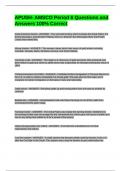Exam (elaborations)
APUSH- AMSCO Period 6 Questions and Answers 100% Correct
- Course
- Institution
APUSH- AMSCO Period 6 Questions and Answers 100% CorrectAPUSH- AMSCO Period 6 Questions and Answers 100% CorrectAPUSH- AMSCO Period 6 Questions and Answers 100% CorrectAPUSH- AMSCO Period 6 Questions and Answers 100% Correct Great American Desert - ANSWER - The vast arid territory which includes t...
[Show more]



